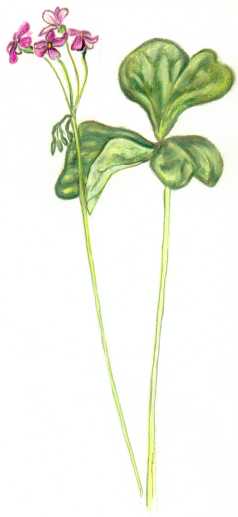 Wood
Sorrel Oxalis acetosella
Wood
Sorrel Oxalis acetosella
The wood sorrel is an attractive little plant, which
looks almost too delicate to be growing wild. Its leaves are three-lobed,
like those of clover, but are soft and downy, whitish beneath but a
distinctive light teal green above; the flowers, which can be seen almost
continuously throughout the summer, are a bright pink, or sometimes white,
and although small appear in great numbers, each one borne upon a long
stalk. The seed pods come later, and have a mechanism by which they
fire out the seeds, like a catapult.
As can be guessed from its name, wood sorrel is a plant of the
shade, which will not grow in full sunlight. It can be found growing
wild in woodlands, scattered across the ground or by the base of trees. It
is also very abundant in and around old cottage gardens, where it was
widely planted in former days for both culinary and medicinal purposes,
not to mention for its flowers. The link between this plant and the common
sorrel is not so obvious. Yet anyone who tastes the leaves of both will
soon find the similarity, for the leaves of sorrel and wood sorrel have
the same very sharp acidic taste. Sorrel has long been used in cooking,
its chopped up leaves being added to soups, dressings and sauces, and wood
sorrel can be eaten in just the same way. In olden times it was grown in
kitchen gardens, alongside other herbs and vegetables.
Wood sorrel has also been called by the names wood sour, sour
trefoil, and more popularly cuckoo’s-meat; gowk-meat is a Scottish
variant of the name and it is known in French as pain de coucou, perhaps
because when wood sorrel is coming into flower the cuckoo can first be
heard. It is also thought that wood sorrel is the true Irish shamrock, as
opposed to the lesser yellow trefoil.